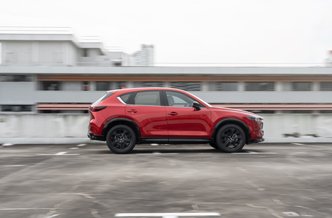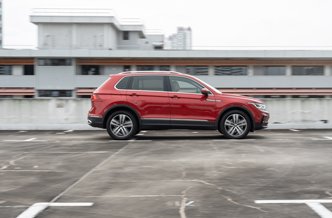Mazda CX-5 2.0 Luxury Sports (A) vs Volkswagen Tiguan 2.0 TSI Elegance (A)
28 Sep 2022|19,563 views
Mazda CX-5
Swankier, more elegant design
More driver-focused
Sweeter handling
Volkswagen Tiguan
More advanced cockpit
Keener performance
Roomier and more practical
For most people, buying a car means listening to your head rather than your heart. Making a sensible, rather than emotional choice, is typically the route for most people.
The two 'red-hot' SUVs here, however, can make buyers question whether to heed their head or their heart. In the 'sensible' corner is the Volkswagen Tiguan. Recently updated, it features improvements to both its exterior and cabin. The biggest change, though, is the return of the 2.0-litre drivetrain, which replaces the 1.4-litre one in the pre-facelift model.
The Mazda CX-5, on the other hand, represents the 'emotional' choice. Apart from its swanky design, it has also been given several significant upgrades that enhance its safety and convenience. However, unlike the Tiguan, the CX-5 hasn't received a performance boost. But as we shall soon see, the SUV has ways of making up for this.
Will this contest end with the head ruling the heart? Or will the heart overrule the head?
Style shootout

The latest Tiguan features a new grille, front bumper and LED head lights. Its rear end, too, has been given a new bumper with exhaust finishers, while the 'Tiguan' badging is now found across the tailgate. It's a clean and smart look for sure.
But sitting beside the CX-5, the Tiguan sort of fades into the background. While the Tiguan looks muscular with its straight lines, the CX-5 and its curves are alluring.
Mazda gave their popular crossover slimmer headlamps and a three-dimensional grille. Depending on the trim level, the grille will have either bright lime green or vivid red detailing. Piano black trim is used for the front spoiler, wheel arches and side skirts, giving the model some elegant contrasts.
Immerse yourself
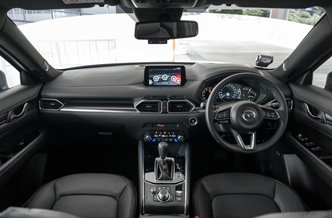 | 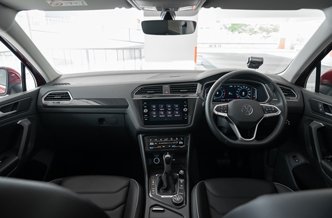 |
Unlike the CX-5's part-analogue, part-digital instrument panel, the Tiguan has always had a full digital cluster. The latest unit here offers various layouts to choose from, and boasts even sharper graphics, too.
There's a new infotainment unit as well. Based on the brand's MIB3 system, it has a cleaner interface with fewer physical buttons. Even the air-con controls have become more advanced, with touch sliders replacing temperature knobs.
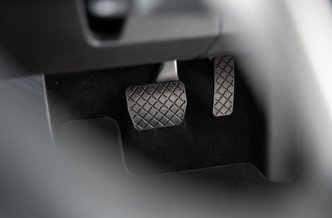 | 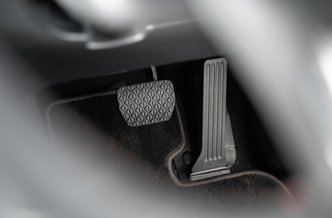 |
Practicality remains a Tiguan strength, too, as the door bins are larger than the CX-5's. The Tiguan also has an additional storage point atop the dashboard, which could be useful for say, spare CashCards.
But while the Tiguan has the lead in terms of tech, the CX-5 has the advantage in terms of overall build quality.
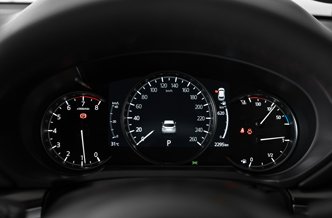 |  |
While the CX-5's mostly analogue gauges might seem dated, they do look good and work as intended. Mazda should have updated the infotainment though, as the screen could be larger, and the graphics much nicer.
That said, the biggest bugbear is that the system tends to feel like it's lagging, especially when compared to the Tiguan's snappy interface.
Backseat matters
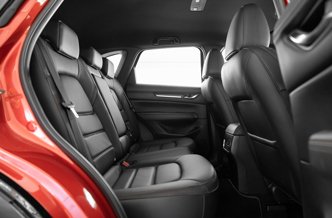 | 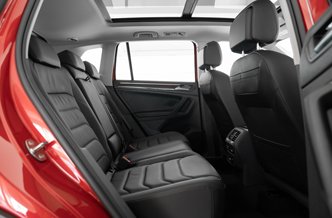 |
The Tiguan's backseat is roomier, and the occupants have their own climate zone as well. There are also larger door bins for loose items, and a panoramic sunroof to make the space feel airier still.
These items aren't offered by the CX-5, so the passengers here must make do with air vents sans climate controls and smaller storage points. What the CX-5 does offer, though, are plusher seats and more headroom, since there's no sunroof.
 | 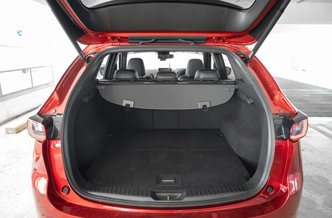 |
Now, the CX-5 also offers the same flexibility and split-folding rear seats.
However, the boot capacity of 442 litres is considerably less than what the Tiguan has.
Opposing approaches
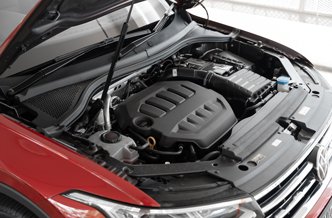 | 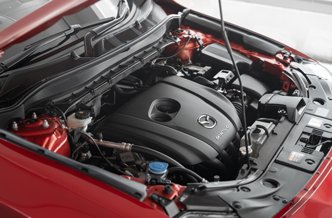 |
This enables the Tiguan's 1,984cc unit to kick out 187bhp and 320Nm. Paired to a seven-speed dual-clutch transmission, the Tiguan finishes the century sprint in 7.4 seconds.
The CX-5's naturally aspirated 1,998cc motor, on the other hand, produces 162bhp and 213Nm. Not surprisingly, the CX-5 takes 10.2 seconds (2.8 seconds longer) to go from zero to 100km/h.
Though down on performance, the CX-5 makes up for it by doing several things really well. The driving position, for instance, is spot on, and takes just a few adjustments for you to get right.
The steering also feels pointier and more communicative than the Tiguan's helm. This may be an SUV, but it's nevertheless still nice to have.
Then there's Mazda's six-speed automatic gearbox. It can't swap cogs as quickly as VW's dual-clutch, but even without selecting 'Sport' mode, the gearbox's initial responses feel snappier.
 | 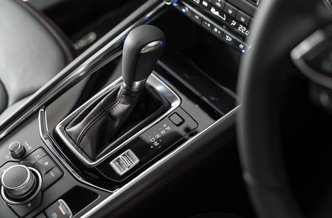 |
But though the Tiguan is quicker and more surefooted thanks to its 4Motion all-wheel drive, the slower, front-wheel drive CX-5 is more fun and engaging to punt around corners.
There's no question though, that the Tiguan has overall performance and ride quality in the bag.
Making the call
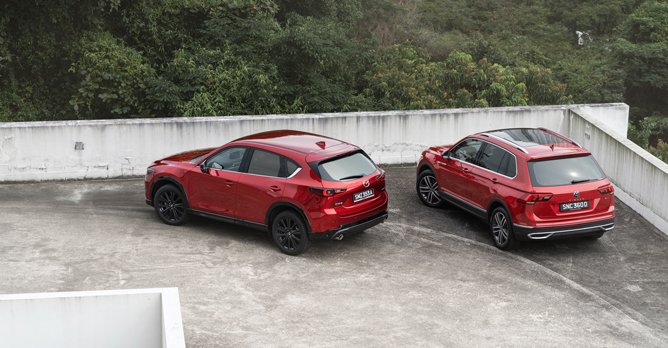
Objectively, the Tiguan is the better family SUV. It offers superior power, practicality and space. And with its digital cockpit, it's more modern as well. You want an SUV that ticks nearly all the boxes? It's this one.
Plus, since both models cost over $200k, the Tiguan's current price of $215,900 isn't that much of a premium over the CX-5, which goes for $201,888.
Now, although the Tiguan is the better option on paper, buying a car isn't always just about finding the model that ticks all the boxes. The car I choose has to appeal to me on other fronts as well, and this is why I'd personally go for the CX-5 (though I acknowedge it has its shortcomings).
The Tiguan's performance and speed are great, but in the CX-5, I can work the engine and enjoy the responsiveness of the gearbox. Practicality is also more than adequate, as my wife and I have no kids. Besides, design is even more critical. I see the CX-5 as something I can both use and admire, and that makes it the more appealing option for me.
Looking to compare more cars? Check out these other Group Tests
Nissan Qashqai faces off against the Skoda Karoq
Honda HR-V lines up alongside the Peugeot 3008
Mercedes-Benz CLA180 goes head-to-head with the BMW 216i Gran Coupe
Opel Mokka takes on the Renault Captur
Polestar 2 Long Range Single Motor goes up against the Tesla Model 3
Audi Q5 lines up alongside the Jaguar F-Pace
Mazda CX-5
Swankier, more elegant design
More driver-focused
Sweeter handling
Volkswagen Tiguan
More advanced cockpit
Keener performance
Roomier and more practical
For most people, buying a car means listening to your head rather than your heart. Making a sensible, rather than emotional choice, is typically the route for most people.
The two 'red-hot' SUVs here, however, can make buyers question whether to heed their head or their heart. In the 'sensible' corner is the Volkswagen Tiguan. Recently updated, it features improvements to both its exterior and cabin. The biggest change, though, is the return of the 2.0-litre drivetrain, which replaces the 1.4-litre one in the pre-facelift model.
The Mazda CX-5, on the other hand, represents the 'emotional' choice. Apart from its swanky design, it has also been given several significant upgrades that enhance its safety and convenience. However, unlike the Tiguan, the CX-5 hasn't received a performance boost. But as we shall soon see, the SUV has ways of making up for this.
Will this contest end with the head ruling the heart? Or will the heart overrule the head?
Style shootout

The latest Tiguan features a new grille, front bumper and LED head lights. Its rear end, too, has been given a new bumper with exhaust finishers, while the 'Tiguan' badging is now found across the tailgate. It's a clean and smart look for sure.
But sitting beside the CX-5, the Tiguan sort of fades into the background. While the Tiguan looks muscular with its straight lines, the CX-5 and its curves are alluring.
Mazda gave their popular crossover slimmer headlamps and a three-dimensional grille. Depending on the trim level, the grille will have either bright lime green or vivid red detailing. Piano black trim is used for the front spoiler, wheel arches and side skirts, giving the model some elegant contrasts.
Immerse yourself
The CX-5's cockpit (left) isn't as high-tech as the Tiguan's, but its tight construction and choice of materials certainly make it feel more upmarket
Now, while the CX-5 certainly has an eye-catching exterior, it is the Tiguan's high-tech cockpit that immediately draws a driver's attention.Unlike the CX-5's part-analogue, part-digital instrument panel, the Tiguan has always had a full digital cluster. The latest unit here offers various layouts to choose from, and boasts even sharper graphics, too.
There's a new infotainment unit as well. Based on the brand's MIB3 system, it has a cleaner interface with fewer physical buttons. Even the air-con controls have become more advanced, with touch sliders replacing temperature knobs.
The Tiguan's pedal setup (left) is less comfortable than the CX-5's, which has an organ-type accelerator pedal
The Tiguan has the edge in terms of functionality, which is not a surprise. The USB-C ports here are convenient as well, since they charge your phone quicker than USB-A ones.Practicality remains a Tiguan strength, too, as the door bins are larger than the CX-5's. The Tiguan also has an additional storage point atop the dashboard, which could be useful for say, spare CashCards.
But while the Tiguan has the lead in terms of tech, the CX-5 has the advantage in terms of overall build quality.
CX-5 (left) still uses mostly analogue meters, whereas buyers expect snazzier full digital panels like the one in the Tiguan
Softer surfaces cover the dashboard, centre armrest and door panels. These components are trimmed with stitching as well, adding to the upmarket impression. If you didn't know better, you'd assume this was a luxury car.While the CX-5's mostly analogue gauges might seem dated, they do look good and work as intended. Mazda should have updated the infotainment though, as the screen could be larger, and the graphics much nicer.
That said, the biggest bugbear is that the system tends to feel like it's lagging, especially when compared to the Tiguan's snappy interface.
Backseat matters
The CX-5's backseat (left) isn't as roomy or useful as the Tiguan's, but it does have softer upholstery to help soothe occupants
Volkswagen did a great job with the rear accommodations, despite the Tiguan's wheelbase being slightly shorter than the CX-5's (2,679mm vs 2,700mm).The Tiguan's backseat is roomier, and the occupants have their own climate zone as well. There are also larger door bins for loose items, and a panoramic sunroof to make the space feel airier still.
These items aren't offered by the CX-5, so the passengers here must make do with air vents sans climate controls and smaller storage points. What the CX-5 does offer, though, are plusher seats and more headroom, since there's no sunroof.
The Tiguan's boot (left) is larger and better for bulky items, although the CX-5's lower loading height makes it easier to load/unload heavy items
The Tiguan ticks the box for cargo-hauling duties, too. Seats up, this SUV boasts a boot volume of 615 litres, and has the flexibility of 40:20:40 split-folding rear seats.Now, the CX-5 also offers the same flexibility and split-folding rear seats.
However, the boot capacity of 442 litres is considerably less than what the Tiguan has.
Opposing approaches
The Tiguan's turbocharged 2.0-litre (left) makes everyday commutes more effortless compared to the CX-5's naturally aspirated powerplant
The Tiguan and CX-5 are polar opposites when it comes to drivetrains. Though both have 2.0-litre four-cylinder engines, the former is turbocharged while the latter is not.This enables the Tiguan's 1,984cc unit to kick out 187bhp and 320Nm. Paired to a seven-speed dual-clutch transmission, the Tiguan finishes the century sprint in 7.4 seconds.
The CX-5's naturally aspirated 1,998cc motor, on the other hand, produces 162bhp and 213Nm. Not surprisingly, the CX-5 takes 10.2 seconds (2.8 seconds longer) to go from zero to 100km/h.
Though down on performance, the CX-5 makes up for it by doing several things really well. The driving position, for instance, is spot on, and takes just a few adjustments for you to get right.
The steering also feels pointier and more communicative than the Tiguan's helm. This may be an SUV, but it's nevertheless still nice to have.
Then there's Mazda's six-speed automatic gearbox. It can't swap cogs as quickly as VW's dual-clutch, but even without selecting 'Sport' mode, the gearbox's initial responses feel snappier.
VW's dual-clutch (left) is definitely faster, but the -/+ points on the CX-5 are in the 'correct' positions, so they're more satisfying to use
Short, sharp stabs to the accelerator pedal are enough to make the transmission kick down sometimes not one gear, but two. This is crucial, since unlike the Tiguan's turbocharged lump, the CX-5's engine needs revs to progress.But though the Tiguan is quicker and more surefooted thanks to its 4Motion all-wheel drive, the slower, front-wheel drive CX-5 is more fun and engaging to punt around corners.
There's no question though, that the Tiguan has overall performance and ride quality in the bag.
Making the call

Objectively, the Tiguan is the better family SUV. It offers superior power, practicality and space. And with its digital cockpit, it's more modern as well. You want an SUV that ticks nearly all the boxes? It's this one.
Plus, since both models cost over $200k, the Tiguan's current price of $215,900 isn't that much of a premium over the CX-5, which goes for $201,888.
Now, although the Tiguan is the better option on paper, buying a car isn't always just about finding the model that ticks all the boxes. The car I choose has to appeal to me on other fronts as well, and this is why I'd personally go for the CX-5 (though I acknowedge it has its shortcomings).
The Tiguan's performance and speed are great, but in the CX-5, I can work the engine and enjoy the responsiveness of the gearbox. Practicality is also more than adequate, as my wife and I have no kids. Besides, design is even more critical. I see the CX-5 as something I can both use and admire, and that makes it the more appealing option for me.
Looking to compare more cars? Check out these other Group Tests
Nissan Qashqai faces off against the Skoda Karoq
Honda HR-V lines up alongside the Peugeot 3008
Mercedes-Benz CLA180 goes head-to-head with the BMW 216i Gran Coupe
Opel Mokka takes on the Renault Captur
Polestar 2 Long Range Single Motor goes up against the Tesla Model 3
Audi Q5 lines up alongside the Jaguar F-Pace
Car Information
Volkswagen Tiguan 2.0 TSI DSG Elegance (A)
CAT B|Petrol|10.8km/L
Horsepower
139kW (187 bhp)
Torque
320 Nm
Acceleration
7.4sec (0-100km /hr)
This model is no longer being sold by local distributor
All Used Volkswagen TiguanMazda CX-5 2.0 Luxury Sports (A)
CAT B|Petrol|14.3km/L
Horsepower
121kW (162 bhp)
Torque
213 Nm
Acceleration
10.2sec (0-100km /hr)
This model is no longer being sold by local distributor
All Used Mazda CX-5Thank You For Your Subscription.



































































